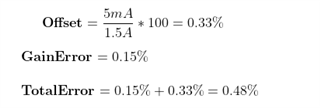Other Parts Discussed in Thread: INA260
- Want to measure a purely resistive load on the order of 100 micro-ohms, with an accuracy of 1% or better
- Not cost sensitive - this circuit could be a couple hundred dollars if needed
- Interface to microcontroller - SPI or I2C
- I was thinking of: Current-output DAC (LTC2662, total output of 1.5 amps for low noise and fast response time, not so much for current measurement capability) in series with INA260 (for current measurement) in series with the 100 micro-ohm load + INA229 (for measurement of voltage drop across load)
- Current-output DACs would be powered with low-noise AC-DC converter (10 mV ripple max, could consider other options if needed)
- Measurement Process (cycle time 500 msec max):
- Turn on DAC to ~1.5 amps max output
- Wait for stabilization (I assume this will be sub 1 msec based upon datasheet)
- Measure INA260 (repeatedly if needed for averaging help) + INA229 (can wait for INA229 averaging as needed)
- Turn off DACs
- Wait for stabilization (I assume this will be sub 1 msec based upon datasheet)
- Remove DUT
- Place new DUT into system
- Repeat
Questions:
- I can tolerate more current (~low tens of milliamps if needed) going through the DUT - does TI have a suggestion for a current-output solution (prefer not to use a voltage supply with a current-limiting/setting resistor since this thing has to live in a small space so power dissipation is a concern) here with sufficiently low noise and rise/fall times of low milliseconds that won't need to dissipate a lot of Watts? Prefer an IC-based solution if available as opposed to a bunch of discrete components
- Or I could parallel more LTC2662 up to a max of 4 units to give 6 amps, but that's not preferred (~$30 per)
- Is this a good circuit overall for the performance targets or do I maybe need a current sense amplifier to better fill the input range of INA229?
- Could consider current-sense amplifier with separate sigma-delta but I'd probably mess up the layout to the point where it wouldn't work as well as your INAXXXs :)



